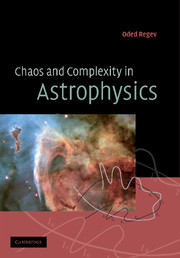Book contents
- Frontmatter
- Contents
- Preface
- Acknowledgements
- Part I Dynamical systems – general
- Part II Astrophysical applications
- 8 Introduction to Part II
- 9 Planetary, stellar and galactic dynamics
- 10 Irregularly variable astronomical point sources
- 11 Complex spatial patterns in astrophysics
- 12 Topics in astrophysical fluid dynamics
- References
- Index
11 - Complex spatial patterns in astrophysics
Published online by Cambridge University Press: 14 January 2010
- Frontmatter
- Contents
- Preface
- Acknowledgements
- Part I Dynamical systems – general
- Part II Astrophysical applications
- 8 Introduction to Part II
- 9 Planetary, stellar and galactic dynamics
- 10 Irregularly variable astronomical point sources
- 11 Complex spatial patterns in astrophysics
- 12 Topics in astrophysical fluid dynamics
- References
- Index
Summary
The aim of science is always to reduce complexity to simplicity.
William James, The Principle of Psychology.The great majority of astronomical systems are at enormous distances from Earth, but the extent of some of them is large enough as to be spatially resolvable in observations. Surveys in the optical as well as in other spectral ranges have revealed an inherently complex spatial distribution of matter (stars and gaseous nebulae) in the Galaxy and beyond. In this chapter we shall discuss some possible applications of nonlinear dynamics and pattern theory to the study of two (a priori unrelated) topics in this context: the complexity of the interstellar medium (ISM), and the properties of the large scale distribution of matter in the universe.
Interstellar clouds are invariably spatially complex and they pose a rather nontrivial challenge to the theorist, whose primary goal is the understanding of the physical processes shaping them. It is plausible that fluid turbulence plays an important role in this respect. This enigmatic problem is still largely unsolved and we shall not discuss here its possible applications to the ISM complexity (some selected aspects of turbulence will be addressed, however, in the next chapter). After briefly reviewing some observational features of the interstellar medium, which are probably relevant to our discussion, we shall mention some theoretical approaches, among them a pattern and complexity forming toy-model and a couple of global models, motivated by mathematical methods of statistical mechanics.
- Type
- Chapter
- Information
- Chaos and Complexity in Astrophysics , pp. 347 - 380Publisher: Cambridge University PressPrint publication year: 2006



